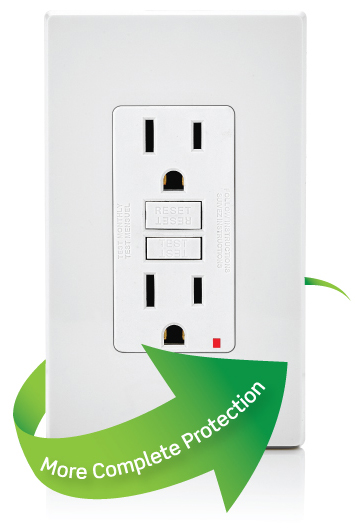
|
|
| GFCI Receptacles Stand the Test of Time | |
|
|
|

GFCI Receptacles Stand the Test of Time for Optimal Protection and End-of-Life (EOL) Action Article by Leviton As lauded in a 2008 Consumer Products Safety Commission (CPSC) paper, GFCIs have contributed significantly to the reduction of electrocution and severe electric shock incidents since their introduction in the early 1970s1 This notable safety achievement can be attributed to decades of research, innovation, communication and cooperation on the part of GFCI manufacturers, regulatory agencies, consumer product watchdogs and electrical industry professionals. Instrumental in the evolution of GFCI safety was the role of Underwriters Laboratories (UL) in responding to an April 20, 2001 request from CPSC that major upgrades to the GFCI standard are needed. These upgrades should include requirements to address resistance to electrical surges, resistance to effects of wet locations, miswiring, and provisions to require that GFCIs cannot be reset if the GFCI is not operable2. This communication came on the heels of a UL convened meeting of the Standards Technical Panel (STP) for GFCIs on March 14-15, 2001. At that meeting, the results of a survey of the field performance of GFCIs sponsored by the National Electrical Manufacturers Association (NEMA) were discussed along with a number of proposals for revisions of the requirements applicable to GFCIs. Added to this momentum was the fact that research indicated many GFCI users were not adhering to industry recommendations to test their GFCIs monthly. The result was a revision to UL 943 Standard so that effective on January 1, 2003 the following requirements were among those specified: This revision aimed to ensure that GFCIs were as robust as possible. Three years later, in a continuing effort to enhance the safety of GFCIs, UL issued new requirements on GFCI functionality to address the important safety issue of Line-Load Reversal Indication during the installation process of GFCI receptacles. Effective July 28, 2006, this revision focused on a potentially hazardous situation relating to instances where the GFCI receptacle face was live and unprotected after installation. The 2006 UL 943 Standard also brought to the forefront the issue of GFCI End of Life (EOL). This standard defined EOL and helped safeguard that GFCI receptacles which are supplying power are also supplying GFCI protection. It is important to note that this EOL initiative was directed at receptacles only. Also of note is that EOL at this time was dependent upon users testing the device to get it to EOL status. Issues with users regularly testing their devices was a concern and this paved the way for the 2015 revision requiring auto-monitoring which we will review next. 2006 UL 943 Standard
Current Standards Although most exceptions given to GFCI circuit breakers in 2006 for meeting EOL requirements were taken away with this revision, there are still significant ones that remain. These exceptions pertain specifically to silicon-controlled rectifiers (SCR) and solenoids, two components common to all tripping mechanisms. These components may be compromised in GFCI circuit breakers and therefore allow the GFCI circuit breaker to potentially remain energized even in an EOL event. Although these components may also be compromised in GFCI receptacles, the significant difference is that GFCI receptacles are required to address this failure. Because of this requirement, GFCI receptacles offer an added layer of protection that GFCI circuit breakers are not required to offer. 2015 UL 943 Standard
Circling back to where we started it is clear that GFCIs help save lives and are essential in any electrical system. However it is concerning that due to UL exceptions, if either the SCR or solenoid fail in a GFCI circuit breaker the end-user may still be able to reset the breaker and unknowingly NOT be protected from ground fault shock or electrocution. A UL certified GFCI receptacle is your assurance of protection in the event of a failed SCR or solenoid.
Article submitted by: Bill Grande Adam Kevelos For additional information, visit Leviton.com
|
||||||||||||||||
|
|
|
| Visit: Exam Preparation | Continuing Education | Code Products | Newsletters | and more | |||
|
|
|||||